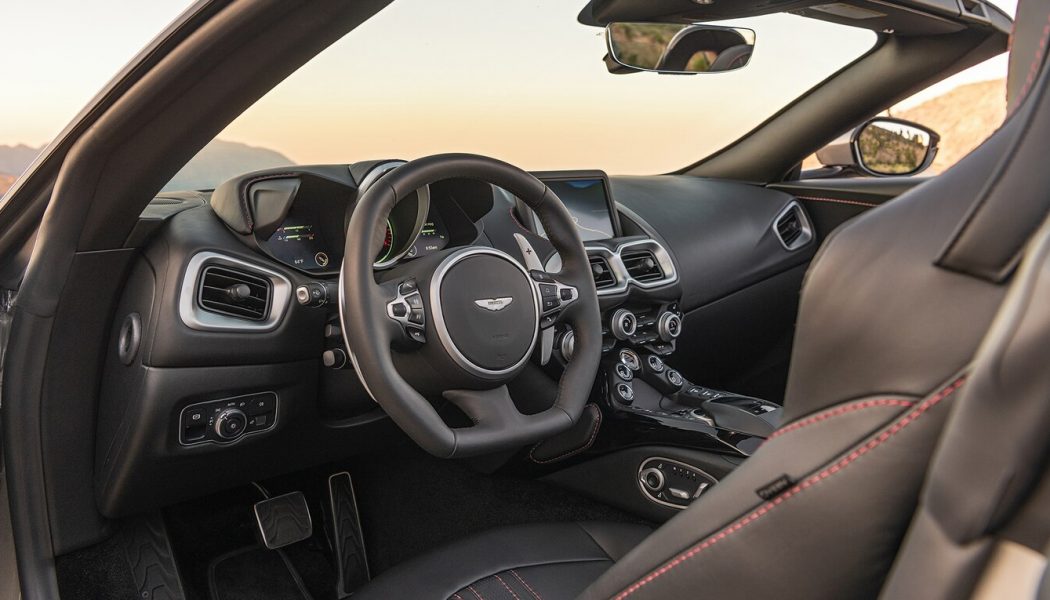No one these days designs a coupe without engineering the car to ensure it can also be built as a convertible. Well, almost no one—the Ferrari Portofino means there won’t be a convertible version of the gorgeous Roma coupe, although since 70 percent of the Roma’s platform is derived from the Portofino, you could argue Maranello simply did things the other way around.
The Vantage Roadster shares much of its hardware with its coupe sibling—the rumbling, AMG-sourced 503-hp 4.0-liter twin-turbo V-8; the rear-mounted eight-speed ZF automatic transmission; the e-diff; the suspension; and the brakes. And it has the same tight, taut, focused feeling as the coupe when you point it at a winding road and punch the gas. The Vantage Roadster is no show pony. It hasn’t been designed to do its best work slowly cruising the boulevards of the south of France—or South Beach, Florida—roof down and looking fabulous. It’s a proper sports car. You can drive it. Hard.
Paradoxically, removing the roof adds weight to sports cars. Without the roof structure to tie everything together, more robust additional bracing must be added elsewhere to give the body the rigidity needed to allow the drivetrain, suspension, and steering to work properly. Engineers also have to package the mechanism for a folding soft top. The Vantage Roadster thus weighs 132 pounds more than the coupe. But it feels just as rigid, with none of the shimmies and shudders through the steering column that still blight some convertibles—even in an era when body engineers have computers to help crunch the numbers. It’s an impressive piece of work.
The extra weight and different aerodynamic profile of the Vantage Roadster means it’s fractionally slower than the Vantage coupe. Aston Martin claims the Roadster will accelerate from zero to 60 mph in 3.7 seconds and hit 190 mph, making it two-tenths of a second slower to 60 than the coupe and 5 mph slower at the top end.
On anywhere other than perhaps a racetrack or a German autobahn, the difference is utterly meaningless. What’s meaningful—and the real appeal of the Vantage Roadster—is that in pretty much every real-world driving scenario you can think of, choosing the soft top doesn’t mean you’ve chosen the soft option.
Roof up, the Vantage Roadster is as snug as the coupe, and no noisier on the freeway. The power soft top features a lightweight Z-fold mechanism and has been designed to nestle neatly behind the twin roll bars, eliminating the need for a hard tonneau. That makes it quick to stow, taking just 6.7 seconds to lower and 6.8 seconds to raise. It has the fastest cycle of any powered cloth roof in the business, Aston says, and it can be actuated at speeds up to 31 mph. A glass screen between the roll bars means turbulence in the cockpit is minimal with the roof down and the side windows up.
Finding the convertible actuator switch might be the most time-consuming part of the process, at least the first time it’s not in the center stack or console where you’d expect but in the door down near the map cubby, where a trunk release typically resides.
Roof down, the Vantage Roadster is all about the noise. In the default Sport drive mode the rumble of the twin-turbo V-8 is overlaid with a muted snap and snarl from the exhaust. Select Sport + or Track mode, and the engine rat-a-tat-tat-tats like a Spitfire strafing an airfield, accompanied by pops and bangs from the exhaust that sound like an ammo dump was hit on the way through. It’s a fun soundtrack out on the open road, but in urban areas it’s a bit embarrassing. Do you really want to drive around your neighborhood in a convertible that sounds like World War III has broken out?
The open-top, however, also allows you to better learn to shift by ear, rather than by glancing at the tachometer. As the revs build, the engine’s throaty, insistent snarl gives way to a scarcely perceptible reediness just as it edges toward redline. A quick click of the aluminum shift pedals, and the ZF eight-speed grabs the next cog.
Key to the Vantage Roadster’s impressive dynamics are subtle revisions to the suspension. The rear shocks have been changed to account for slightly extra weight over the rear axle, and the adaptive suspension and stability control calibrations revised. The standard wheel/tire combination is 20-inch rollers shod with 255/40 and 295/35 Pirelli P Zero tires front and rear. Both cars we drove—one in England and one in California—were fitted with lightweight 20-inch forged alloy wheels, a $4,600 option. The meaty Pirelli P Zero rear 295/35/20s do create a fair amount of road roar that enters the cabin, but that’s all part of the experience.
On a dash up Angeles Crest Highway in the California-based test car, the Aston distinguishes itself from its German or Italian rivals by being more about caressing corners rather than attacking them. That’s not to say the Vantage Roadster is without hard-charging spirit; roll onto the accelerator pedal with passion, and the Aston will grunt down on its rear haunches. You feel this response in the small of your back, in your loins, in your amygdala. Slowing down on ACH’s notoriously choppy braking zones, the Aston responds better to an earlier brushing of the brakes, rather than a late stomp that tends to make the rear end swim a bit (of course, some folks prefer it that way).
Other options include the Q Exclusive Spirit Silver paint ($7,600) and the Premium Audio system ($2,300), and comfort and tech “collections”—($2,500 and $3,000 respectively),which get you blind-spot monitoring, parking assist, and 16-way heated memory seats (another $1,600 gets ventilated seats, too.)
But the most significant option fitted to our test car in England was the new “vane grille.” Essentially a redesigned nosecone that replaces the Vantage’s gaping catfish maw with a front graphic that looks more traditionally Aston Martin, it’s the best $2,300 you can spend when ordering your Vantage Roadster. It’s also an option on the 2021 Vantage coupe. Aston Martin sources have confirmed it will be available through U.S. dealers as a retrofit, though details on pricing had yet to be confirmed.
The Aston Martin Vantage Roadster is scheduled to go on sale in the U.S. late in the fourth quarter of this year, with prices starting at $150,086.
Mark Rechtin contributed to this review.










